August 6, 2012 at 10:44 am
[caption id="attachment_387" align="alignleft" width="300"]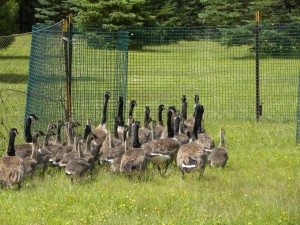 Corralling geese into the pen[/caption]
About a month ago I had the opportunity to go out with our wildlife biologists when they were banding Canada geese. Flocks of geese are banded beginning in late June and continuing into the first 2 or 3 weeks of July. This time period is crucial to the success of the project as it is the time of year when adult geese are molting their wing feathers and are thus flightless for 4-5 weeks until their feathers have grown back in. The banding has been done annually since 2002 and gives biologists information on hunter harvest rates of resident Canada geese.
So, how exactly do biologists go about getting their hands on a flock of birds? When the wing molt is in full swing, biologists gather with groups of dedicated volunteers and go out to where the flocks they would like to target are residing. The group stealthily fans out around the birds and slowly, gently encourages the flock toward a temporary funnel and pen rig that the biologists have erected moments before the push. This step must be done carefully and slowly as the goal is not to frighten the birds but to calmly encourage them to walk into the pen at which point a make-shift door is closed behind them. The birds are then handed out of the pen and placed into temporary holding crates until they can be “worked up”, or in other words, until they can be banded and checked for age and gender.
[caption id="attachment_388" align="alignright" width="300"]
Corralling geese into the pen[/caption]
About a month ago I had the opportunity to go out with our wildlife biologists when they were banding Canada geese. Flocks of geese are banded beginning in late June and continuing into the first 2 or 3 weeks of July. This time period is crucial to the success of the project as it is the time of year when adult geese are molting their wing feathers and are thus flightless for 4-5 weeks until their feathers have grown back in. The banding has been done annually since 2002 and gives biologists information on hunter harvest rates of resident Canada geese.
So, how exactly do biologists go about getting their hands on a flock of birds? When the wing molt is in full swing, biologists gather with groups of dedicated volunteers and go out to where the flocks they would like to target are residing. The group stealthily fans out around the birds and slowly, gently encourages the flock toward a temporary funnel and pen rig that the biologists have erected moments before the push. This step must be done carefully and slowly as the goal is not to frighten the birds but to calmly encourage them to walk into the pen at which point a make-shift door is closed behind them. The birds are then handed out of the pen and placed into temporary holding crates until they can be “worked up”, or in other words, until they can be banded and checked for age and gender.
[caption id="attachment_388" align="alignright" width="300"]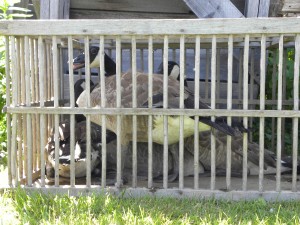 Geese in temporary cage waiting to be 'worked up'.[/caption]
Aging for this project is no more complicated than classifying it as hatching year (HY), meaning that bird was hatched that same year, or after hatching year (AHY), meaning the bird is an adult. This can be determined using a couple of different techniques. Some HY birds still look like classic goslings, with yellowish, down-covered little bodies and stunted wings. Other HY birds have blackish heads with dirty-looking brown or grayish cheek patches and brown or gray adult looking bodies. A look at the tail will also help determine age of older hatching year birds. A tail feather from an adult bird comes to a point, like most feathers, but on a HY bird, some of the tail feathers will still have an inverted point, where you can see the shaft, or middle part, of the feather but the vanes, or parts that make the feather soft, do not extend all the way to the end of the shaft.
[caption id="attachment_391" align="alignleft" width="300"]
Geese in temporary cage waiting to be 'worked up'.[/caption]
Aging for this project is no more complicated than classifying it as hatching year (HY), meaning that bird was hatched that same year, or after hatching year (AHY), meaning the bird is an adult. This can be determined using a couple of different techniques. Some HY birds still look like classic goslings, with yellowish, down-covered little bodies and stunted wings. Other HY birds have blackish heads with dirty-looking brown or grayish cheek patches and brown or gray adult looking bodies. A look at the tail will also help determine age of older hatching year birds. A tail feather from an adult bird comes to a point, like most feathers, but on a HY bird, some of the tail feathers will still have an inverted point, where you can see the shaft, or middle part, of the feather but the vanes, or parts that make the feather soft, do not extend all the way to the end of the shaft.
[caption id="attachment_391" align="alignleft" width="300"]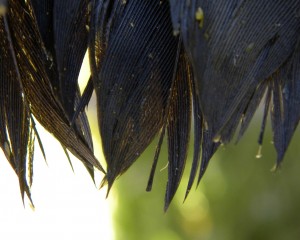 The inverted point of a tail feather, indicating this is a HY bird.[/caption]
Sexing Canada geese is a little more difficult, as geese are sexually monomorphic. This is just a fancy way of saying that the males and females look alike. To sex a goose, a cloacal exam must be conducted. In animals with only one opening for excrement instead of two, that opening is called a cloaca. A cloacal exam is the act of bending back the tail slightly and gently applying lateral, inward pressure with one’s fingers at the cloaca. What biologists are looking for when they do this is what appears as a couple of little rice-like projections that will become evident, indicating the animal is a male. If there are no rice-like projections, it is a female.
Banding is the last step before releasing the bird. A silver, federal band with a unique number code pounded into it is placed on either leg of the bird. The bands are circular and designed to ‘lock’ closed when the open ends are squeezed together with pliers. A properly placed band will hinder the bird only as much as bracelets hinder people. They are roomy around the leg and the ‘lock’ feature means there are no sharp or pointed edges that could potentially harm the bird or get caught up on things.
Lastly, the birds are released back toward the area they were corralled from. HY birds are released with at least one AHY bird to ensure they have somebody to follow back to their residence and won’t get lost on the way.
[caption id="attachment_389" align="alignright" width="300"]
The inverted point of a tail feather, indicating this is a HY bird.[/caption]
Sexing Canada geese is a little more difficult, as geese are sexually monomorphic. This is just a fancy way of saying that the males and females look alike. To sex a goose, a cloacal exam must be conducted. In animals with only one opening for excrement instead of two, that opening is called a cloaca. A cloacal exam is the act of bending back the tail slightly and gently applying lateral, inward pressure with one’s fingers at the cloaca. What biologists are looking for when they do this is what appears as a couple of little rice-like projections that will become evident, indicating the animal is a male. If there are no rice-like projections, it is a female.
Banding is the last step before releasing the bird. A silver, federal band with a unique number code pounded into it is placed on either leg of the bird. The bands are circular and designed to ‘lock’ closed when the open ends are squeezed together with pliers. A properly placed band will hinder the bird only as much as bracelets hinder people. They are roomy around the leg and the ‘lock’ feature means there are no sharp or pointed edges that could potentially harm the bird or get caught up on things.
Lastly, the birds are released back toward the area they were corralled from. HY birds are released with at least one AHY bird to ensure they have somebody to follow back to their residence and won’t get lost on the way.
[caption id="attachment_389" align="alignright" width="300"]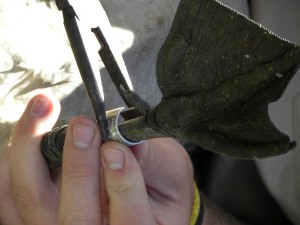 Attaching a band to a goose's leg.[/caption]
Goose banding is an effort conducted statewide. In a short period of time, IFW biologists and volunteers banded 560 resident Canada geese in Southern, Western, Central, and Mid-coast Maine. Typically 10-15% of the banded birds are returned each year in hunter harvest counts.
I was incredibly thankful to have the opportunity to take part in this fascinating process! It is one of the many examples of the various methods used to monitor wildlife harvest rates so that populations can be managed at a healthy and socially acceptable level. Remember, if you are a hunter and shoot a banded goose, please report it! Reporting of returned bands is vital to the success of these studies. Also, having lots of people in the group to go after the geese when they are banded is crucial to the successful banding of the flock! If you’re interested in volunteering, please contact your Regional Biologist early next June to see when you can help! To report a banded bird, please call 1-800-327-BAND (2263) or go online to www.reportband.gov.
[caption id="attachment_390" align="alignnone" width="300"]
Attaching a band to a goose's leg.[/caption]
Goose banding is an effort conducted statewide. In a short period of time, IFW biologists and volunteers banded 560 resident Canada geese in Southern, Western, Central, and Mid-coast Maine. Typically 10-15% of the banded birds are returned each year in hunter harvest counts.
I was incredibly thankful to have the opportunity to take part in this fascinating process! It is one of the many examples of the various methods used to monitor wildlife harvest rates so that populations can be managed at a healthy and socially acceptable level. Remember, if you are a hunter and shoot a banded goose, please report it! Reporting of returned bands is vital to the success of these studies. Also, having lots of people in the group to go after the geese when they are banded is crucial to the successful banding of the flock! If you’re interested in volunteering, please contact your Regional Biologist early next June to see when you can help! To report a banded bird, please call 1-800-327-BAND (2263) or go online to www.reportband.gov.
[caption id="attachment_390" align="alignnone" width="300"]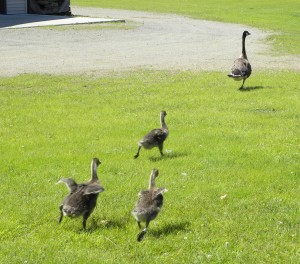 Adult bird released with 3 goslings, all banded.[/caption]
Adult bird released with 3 goslings, all banded.[/caption]
 Corralling geese into the pen[/caption]
About a month ago I had the opportunity to go out with our wildlife biologists when they were banding Canada geese. Flocks of geese are banded beginning in late June and continuing into the first 2 or 3 weeks of July. This time period is crucial to the success of the project as it is the time of year when adult geese are molting their wing feathers and are thus flightless for 4-5 weeks until their feathers have grown back in. The banding has been done annually since 2002 and gives biologists information on hunter harvest rates of resident Canada geese.
So, how exactly do biologists go about getting their hands on a flock of birds? When the wing molt is in full swing, biologists gather with groups of dedicated volunteers and go out to where the flocks they would like to target are residing. The group stealthily fans out around the birds and slowly, gently encourages the flock toward a temporary funnel and pen rig that the biologists have erected moments before the push. This step must be done carefully and slowly as the goal is not to frighten the birds but to calmly encourage them to walk into the pen at which point a make-shift door is closed behind them. The birds are then handed out of the pen and placed into temporary holding crates until they can be “worked up”, or in other words, until they can be banded and checked for age and gender.
[caption id="attachment_388" align="alignright" width="300"]
Corralling geese into the pen[/caption]
About a month ago I had the opportunity to go out with our wildlife biologists when they were banding Canada geese. Flocks of geese are banded beginning in late June and continuing into the first 2 or 3 weeks of July. This time period is crucial to the success of the project as it is the time of year when adult geese are molting their wing feathers and are thus flightless for 4-5 weeks until their feathers have grown back in. The banding has been done annually since 2002 and gives biologists information on hunter harvest rates of resident Canada geese.
So, how exactly do biologists go about getting their hands on a flock of birds? When the wing molt is in full swing, biologists gather with groups of dedicated volunteers and go out to where the flocks they would like to target are residing. The group stealthily fans out around the birds and slowly, gently encourages the flock toward a temporary funnel and pen rig that the biologists have erected moments before the push. This step must be done carefully and slowly as the goal is not to frighten the birds but to calmly encourage them to walk into the pen at which point a make-shift door is closed behind them. The birds are then handed out of the pen and placed into temporary holding crates until they can be “worked up”, or in other words, until they can be banded and checked for age and gender.
[caption id="attachment_388" align="alignright" width="300"] Geese in temporary cage waiting to be 'worked up'.[/caption]
Aging for this project is no more complicated than classifying it as hatching year (HY), meaning that bird was hatched that same year, or after hatching year (AHY), meaning the bird is an adult. This can be determined using a couple of different techniques. Some HY birds still look like classic goslings, with yellowish, down-covered little bodies and stunted wings. Other HY birds have blackish heads with dirty-looking brown or grayish cheek patches and brown or gray adult looking bodies. A look at the tail will also help determine age of older hatching year birds. A tail feather from an adult bird comes to a point, like most feathers, but on a HY bird, some of the tail feathers will still have an inverted point, where you can see the shaft, or middle part, of the feather but the vanes, or parts that make the feather soft, do not extend all the way to the end of the shaft.
[caption id="attachment_391" align="alignleft" width="300"]
Geese in temporary cage waiting to be 'worked up'.[/caption]
Aging for this project is no more complicated than classifying it as hatching year (HY), meaning that bird was hatched that same year, or after hatching year (AHY), meaning the bird is an adult. This can be determined using a couple of different techniques. Some HY birds still look like classic goslings, with yellowish, down-covered little bodies and stunted wings. Other HY birds have blackish heads with dirty-looking brown or grayish cheek patches and brown or gray adult looking bodies. A look at the tail will also help determine age of older hatching year birds. A tail feather from an adult bird comes to a point, like most feathers, but on a HY bird, some of the tail feathers will still have an inverted point, where you can see the shaft, or middle part, of the feather but the vanes, or parts that make the feather soft, do not extend all the way to the end of the shaft.
[caption id="attachment_391" align="alignleft" width="300"] The inverted point of a tail feather, indicating this is a HY bird.[/caption]
Sexing Canada geese is a little more difficult, as geese are sexually monomorphic. This is just a fancy way of saying that the males and females look alike. To sex a goose, a cloacal exam must be conducted. In animals with only one opening for excrement instead of two, that opening is called a cloaca. A cloacal exam is the act of bending back the tail slightly and gently applying lateral, inward pressure with one’s fingers at the cloaca. What biologists are looking for when they do this is what appears as a couple of little rice-like projections that will become evident, indicating the animal is a male. If there are no rice-like projections, it is a female.
Banding is the last step before releasing the bird. A silver, federal band with a unique number code pounded into it is placed on either leg of the bird. The bands are circular and designed to ‘lock’ closed when the open ends are squeezed together with pliers. A properly placed band will hinder the bird only as much as bracelets hinder people. They are roomy around the leg and the ‘lock’ feature means there are no sharp or pointed edges that could potentially harm the bird or get caught up on things.
Lastly, the birds are released back toward the area they were corralled from. HY birds are released with at least one AHY bird to ensure they have somebody to follow back to their residence and won’t get lost on the way.
[caption id="attachment_389" align="alignright" width="300"]
The inverted point of a tail feather, indicating this is a HY bird.[/caption]
Sexing Canada geese is a little more difficult, as geese are sexually monomorphic. This is just a fancy way of saying that the males and females look alike. To sex a goose, a cloacal exam must be conducted. In animals with only one opening for excrement instead of two, that opening is called a cloaca. A cloacal exam is the act of bending back the tail slightly and gently applying lateral, inward pressure with one’s fingers at the cloaca. What biologists are looking for when they do this is what appears as a couple of little rice-like projections that will become evident, indicating the animal is a male. If there are no rice-like projections, it is a female.
Banding is the last step before releasing the bird. A silver, federal band with a unique number code pounded into it is placed on either leg of the bird. The bands are circular and designed to ‘lock’ closed when the open ends are squeezed together with pliers. A properly placed band will hinder the bird only as much as bracelets hinder people. They are roomy around the leg and the ‘lock’ feature means there are no sharp or pointed edges that could potentially harm the bird or get caught up on things.
Lastly, the birds are released back toward the area they were corralled from. HY birds are released with at least one AHY bird to ensure they have somebody to follow back to their residence and won’t get lost on the way.
[caption id="attachment_389" align="alignright" width="300"] Attaching a band to a goose's leg.[/caption]
Goose banding is an effort conducted statewide. In a short period of time, IFW biologists and volunteers banded 560 resident Canada geese in Southern, Western, Central, and Mid-coast Maine. Typically 10-15% of the banded birds are returned each year in hunter harvest counts.
I was incredibly thankful to have the opportunity to take part in this fascinating process! It is one of the many examples of the various methods used to monitor wildlife harvest rates so that populations can be managed at a healthy and socially acceptable level. Remember, if you are a hunter and shoot a banded goose, please report it! Reporting of returned bands is vital to the success of these studies. Also, having lots of people in the group to go after the geese when they are banded is crucial to the successful banding of the flock! If you’re interested in volunteering, please contact your Regional Biologist early next June to see when you can help! To report a banded bird, please call 1-800-327-BAND (2263) or go online to www.reportband.gov.
[caption id="attachment_390" align="alignnone" width="300"]
Attaching a band to a goose's leg.[/caption]
Goose banding is an effort conducted statewide. In a short period of time, IFW biologists and volunteers banded 560 resident Canada geese in Southern, Western, Central, and Mid-coast Maine. Typically 10-15% of the banded birds are returned each year in hunter harvest counts.
I was incredibly thankful to have the opportunity to take part in this fascinating process! It is one of the many examples of the various methods used to monitor wildlife harvest rates so that populations can be managed at a healthy and socially acceptable level. Remember, if you are a hunter and shoot a banded goose, please report it! Reporting of returned bands is vital to the success of these studies. Also, having lots of people in the group to go after the geese when they are banded is crucial to the successful banding of the flock! If you’re interested in volunteering, please contact your Regional Biologist early next June to see when you can help! To report a banded bird, please call 1-800-327-BAND (2263) or go online to www.reportband.gov.
[caption id="attachment_390" align="alignnone" width="300"] Adult bird released with 3 goslings, all banded.[/caption]
Adult bird released with 3 goslings, all banded.[/caption]Categories